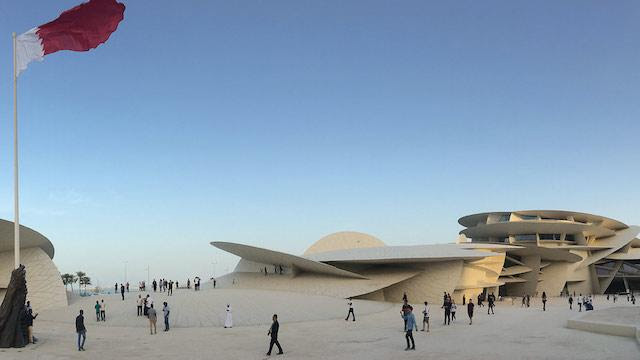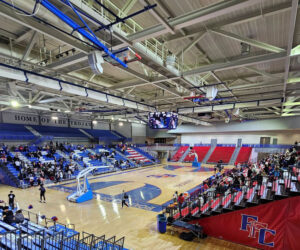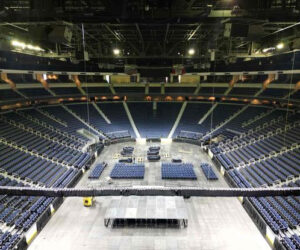The new National Museum of Qatar in Doha, a physically striking structure designed by noted architect Jean Nouvel, offers more than 86,000 square feet of exhibit space with multiple interconnected galleries offering towering walls of video and immersive multi-dimensional audio generated using FLUX::Immersive’s SPAT Revolution platform
The museum’s audio design was created by Basel, Switzerland-based Idee und Klang, which has been working with the immersive format for more than 15 years. Against that backdrop, company founder Ramon De Marco notes that the Qatar project is unique in several ways.
“The museum itself is a very large and unusual space, with each of the galleries having its own architectural and acoustical character,” De Marco explains. “Each gallery has its own theme, with different large-scale multidimensional video presentations and of course, different audio accompanying that, each one created by different composers and sound designers.”

With multi-channel sound an important aspect of each gallery’s presentation, the complexities of producing and mixing multiple channels of audio for each space was just the beginning. “We specified 64 channels for each gallery – almost 700 speakers in all,” reports audio scenographer and designer Daniel Teige. Meyer Sound provided the loudspeakers for the project, which was mixed using Spat Revolution.
Placement of the loudspeakers was also an issue, adds De Marco. “The architects were adamant that they did not want to see any speakers. They originally wanted speakers only on the ceiling, which, depending on the gallery, ranged from four to 20 meters high. Achieving any kind of directionality would have been pretty much impossible, and eventually we were able to lobby for locating some speakers at the bottom of the walls, where we had about eight centimeters of clearance. Meyer Sound had a compact speaker, the UP4slim, that we were able to implement in that limited space.”
Creating an immersive audio experience for a single space can be challenging, but developing multiple environments for adjoining spaces is far more complex. “A lot of sound scenography is about understanding spaces, and how sound behaves in a space,” Teige says. “Using Spat, we were able to create a concept of how to deal with the sound, and adapt it to the theme of each gallery.”

In addition to the sonic issues of overlap from adjacent galleries, De Marco points to the project’s diversity as another challenge. “We worked with each of the composers to create style guides, determine what sounds they would use, and how it would all be configured,” he explains. “Most of the composers were more experienced in composing for TV documentaries, and not necessarily accustomed to creating for multichannel immersive environments. We worked with them not only in terms of what kind of sounds they would use, but also the material they would deliver, so we were able to adapt it to multi-channel mixes. Instead of receiving one or two WAV files, we were getting 50- or 60-channel mixes that sometimes contained literally hundreds or even thousands of clips, to orchestrate into a space.”
Composer Stratis Skandalakis, with a long history of creating immersive compositions for exhibitions, including traveling globally to gather field recordings, worked with the project’s wide array of composers and circumstances, mixing each of the projects using Spat Revolution. “It was pretty challenging at times,” he reports. “Some of the composers had no previous experience with multichannel mixing, and were not accustomed to having a conversation about for example, where to place a sound in a 360-degree space. Often I would be working with a director on my left, and a sound designer on my right, and dealing with a very complex mix with maybe 50 channels, explaining why it takes time for the additional sound design.”

Skandalakis points to working with SPAT Revolution as key to addressing the widely diverse range of material the team had to work with. “It was a first for me to work with multiple formats at the same time,” he says. “With Spat we were able to take stereo, mono, ambisonic, 5.1, and throw them all together. It was a great tool for sound design and for special effects as well. You can make very fast movements, really play with the object-based mixing.”
For De Marco and the Idee und Klang team, it was their first experience working with SPAT Revolution. “We compared several different immersive software programs, and Spat was really the most intuitive, as well as the best sonic quality,” De Marco concludes. “It’s far more than just a surround panner – it’s a room simulation tool that offers many opportunities to choose different algorithms. And the people at FLUX:: were great to work with. Gael and the others were really supportive. We ran into very few issues, but any time we had a question, we would call and right away, we would have a new update. SPAT Revolution is really the only software I would choose for a project like this one.”





















